#Karl XIV. Johann
Text
Joséphine, staring upwards: So, Napoleon broke up with me… haha…
Bernadotte: Why are you looking up?
Joséphine: I need to cry, but my foundation was 48 dollars!
#History Meme#Napoleonic Wars#Joséphine de Beauharnais#Jean Baptiste Bernadotte#Karl XIV. Johann#Queue post
30 notes
·
View notes
Text
The most beautiful old cafes in the world


It's hard to believe, but some cafes have existed for several centuries. Just imagine that you can go for a coffee and you will be surrounded by objects that are already 200, or even 300 years old. And how many stories such establishments keep! In this article, we'll highlight 30 old retro cafes you might want to visit on your next trip.
Cafe Chris, Amsterdam
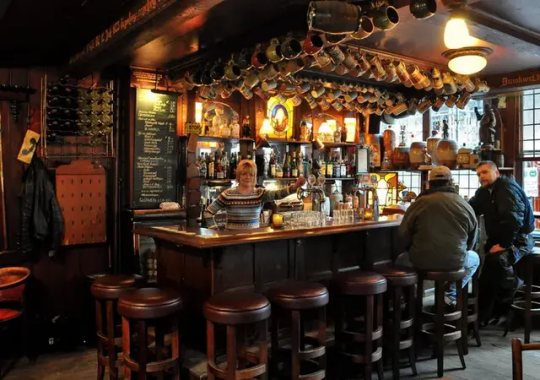
Location: Bloemstraat 42, 1015 TB Amsterdam, Netherlands
Cafe Chris is the oldest establishment in Amsterdam, founded in 1624 in the Jordaan district. Due to its dark interior, it is also called “Brown Cafe”. Once upon a time, workers who were building the Westerkerk bell tower came here for wages. The cafe still has old floorboards, backlit windows, and dark wood paneling.
Gran Caffe Quadri, Venice

Location: Piazza San Marco, 121, 30124 Venezia VE, Italy
The establishment opened its doors in 1638 - then it was called Il Rimedio. Malvasia wine was served here and was said to “invigorate the body and awaken the mind.” In 1775, merchant Giorgio Quadri and his wife Naxina, who arrived from Corfu, decided to invest in this cafe. This is how the history of Gran Caffe Quadri began. In 1830, management passed to the Vaerini brothers, who expanded the establishment by one more floor. In 2011, the Alaimo family bought the cafe. In 2018, Gran Caffe Quadri underwent a major renovation. The famous French creative and designer Philippe Starck was invited to transform it.
Cafe Procope, Paris
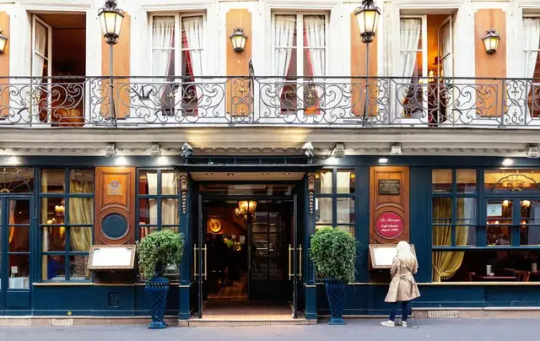
Location: 13 Rue de l'Ancienne Comédie, 75006 Paris, France
Café Procope is the first literary café in Paris. It was discovered in 1686 by Sicilian immigrant Francesco Procopio dei Coltelli - after whom it took its name. Following the traditions of the Procopio family, who ran the establishment for many years, the cafe serves sorbet and granita (crushed ice), the forerunners of ice cream. King Louis XIV appointed Café Procope as the exclusive producer of sorbets. Its famous visitors include Napoleon, Honoré de Balzac, Paul Verlaine, Victor Hugo and Voltaire.
Cafe Tomaselli, Salzburg
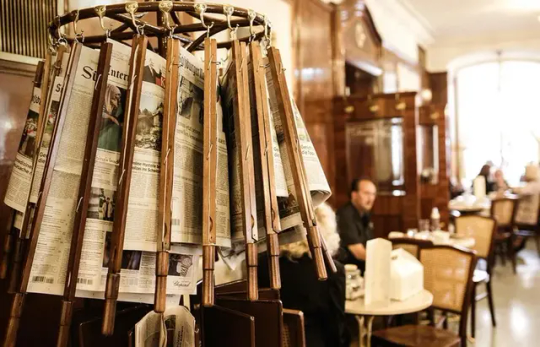
Location: Alter Markt 9, 5020 Salzburg, Austria
In the center of Salzburg, on the Alter Markt square, there is the Tomaselli cafe, perhaps one of the most famous in the world. Family-owned for centuries, this restaurant embodies stylish Austrian coffee culture. The first cafe was opened here in 1703, and in 1852 it was bought by Karl Tomaselli. Mozart and his wife Constance, playwright Hugo von Hofmannsthal, and composer Carl Weber loved to visit it.
Cafe Tomaselli recommends trying the Einspänner (double espresso with cold whipped cream) and Melange (an espresso-based coffee drink with the addition of heated and frothed milk and whipped cream).
Caffe Florian, Venice
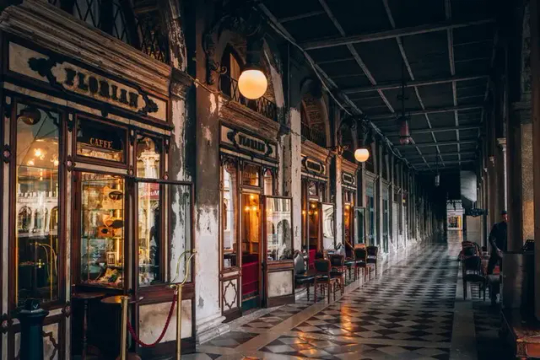
Location: Piazza San Marco, 57, 30124 Venezia VE, Italy
Caffe Florian is one of the first cafes in what is now Italy. It was opened in 1720 under the name Alla Venezia Trionfante. The establishment gained popularity due to the fact that both men and women could visit it - in those years this was very rare. Over time, the cafe began to be called Florian - in honor of the owner Floriani Francesconi. In 1760, the sales point for Venice's first newspaper, Gazzetta Veneta, was opened here.
At different times, the cafe was visited by Jean-Jacques Rousseau, Johann Goethe, Charles Dickens, George Byron, Giacomo Casanova, Ernest Hemingway and others.
Today, Caffe Florian offers more than 30 varieties of coffee drinks, many desserts, salads and light snacks.
Antico Caffe Greco, Rome
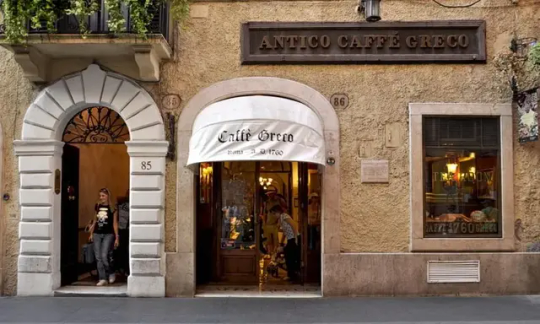
Location: Via dei Condotti, 86, 00187 Roma RM, Italy
Antico Caffè Greco is a historical café in Rome, opened in 1760. Its founder is the Greek Nicola della Maddalena. Over the centuries, the elegant Caffè Greco has been visited by Hans Christian Andersen, George Byron, Henrik Ibsen, John Keats, Mark Twain and others. Some 300 paintings, memorabilia and vintage photographs of famous clients adorn the walls of this establishment. And gilded mirrors and a piano help maintain an authentic atmosphere.
Caffè Al Bicerin, Turin
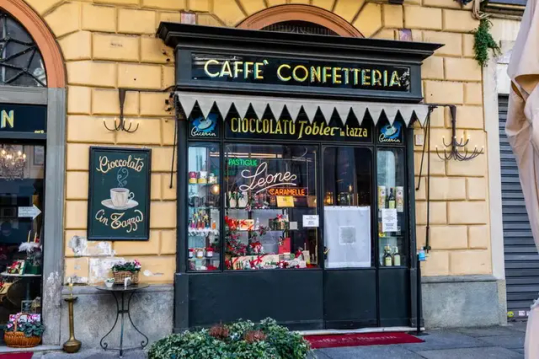
Location: Piazza della Consolata, 5, 10122 Torino TO, Italy
The history of the establishment began in 1763, when Giuseppe Dentis opened his small shop in the premises opposite the entrance to the Santuario della Consolata Cathedral. In 1856, the current building was built here according to the design of the architect Carlo Promis. And then the cafe acquired a more elegant form, which we can appreciate today - its walls were decorated with wooden panels, mirrors and lamps. It now has round white marble tables, a counter, and shelves.
This establishment was the birthplace of the famous Turin drink Bicerin - a mixture of coffee, chocolate, milk and syrup. Even Alexandre Dumas mentioned it in one of his novels.
El Fishawy, Cairo

Location: El-Gamaleya, El Gamaliya, Cairo Governorate, Egypt
El Fishawy Café is hidden in the heart of Khan Al Khalili Souk. Its doors opened to visitors in 1773. The first owner of the establishment served Turkish coffee to his friends after sunset. There were more and more people wanting to enjoy a cup of aromatic drink and discuss city news. And then the owner bought buildings nearby, added even more items and hookah to the menu. The current owners of El Fishawy, heirs of the founder, are trying to preserve the traditions and atmosphere of the establishment.
Cafe Tortoni, Buenos Aires, 1858

Location: Av. de Mayo 825, C1084 Buenos Aires, Argentina
Cafe Tortoni is considered the oldest in Argentina. It was opened by an emigrant from France in 1858 and named after the café of the same name in Paris. It is worth noting that the first premises of Cafe Tortoni were located on Avenida Rivadavia. The cafe moved to its current location in 1880. The owners have maintained the same style of the establishment throughout all the years of its existence. There is a tango room, as well as tables for playing billiards, dominoes and dice.
His most famous guests were Garcia Lorca, Jorge Luis Borges, Carlos Gardel, Hillary Clinton, Albert Einstein, Robert Duvall.
Café Gerbeaud, Budapest
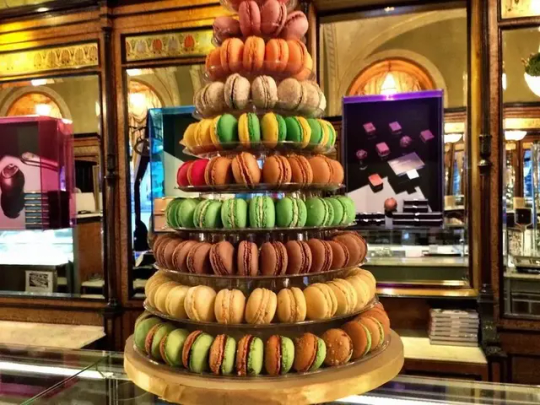
Location: Budapest, Vörösmarty tér 7-8, 1051 Hungary
Café Gerbeaud is the most famous cafe in Europe, whose history began in 1858. Its founder is Henrik Kugler, a representative of the third generation of a dynasty of confectioners. He became the first to offer customers slices of his signature Coogler cake to-go in cardboard boxes. During a visit to Paris in 1882, Henrik Kugler met Emil Gerbaud - they soon became business partners. And later, a French confectioner entrepreneur bought the cafe completely.
With the advent of Gerbeau, many changes took place in the confectionery - the menu expanded, the equipment changed, and the staff increased. Café Gerbeaud became a favorite place not only among city residents, but also among city guests, since the prices here were affordable for absolutely everyone. After Emile Gerbeau's death in 1919, his wife ran the confectionery. From 1950 to 1984 the cafe was nationalized and was called Vörösmarty. In 1995, Café Gerbeaud was bought by German entrepreneur Erwin Franz Müller. The establishment was renovated and restored to its historical appearance.
Gran Caffè Gambrinus, Naples, Italy
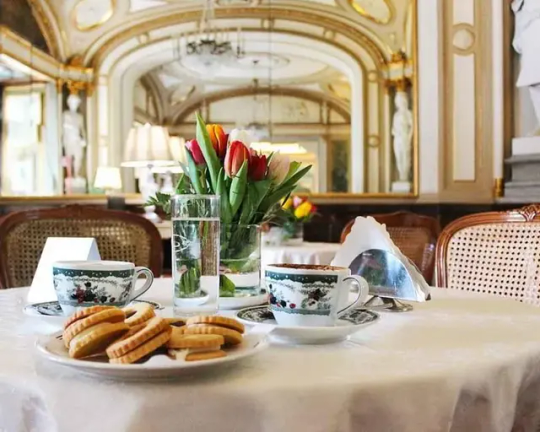
Location: Via Chiaia, 1/2, 80132 Napoli NA, Italy
The legendary coffee shop is located in the center of Naples. The establishment was founded by Vincenzo Apuzzo in 1860 - his dream was to create the best cafe in Italy. The next owner was Mario Vacca in 1889. By that time, the premises were already in need of reconstruction. The owner of the cafe invited an architect and artists who worked on updating the interior. Their paintings and sculptures adorn Caffè Gambrinus to this day.
The establishment was once visited by Matilda Serao, Ernest Hemingway, Oscar Wilde, Guy de Maupassant, Princess Sissi, and Emile Zola. By the way, the tradition of caffé sospeso was born here - paying for coffee for the next customer.
Cafe de la Paix, Paris
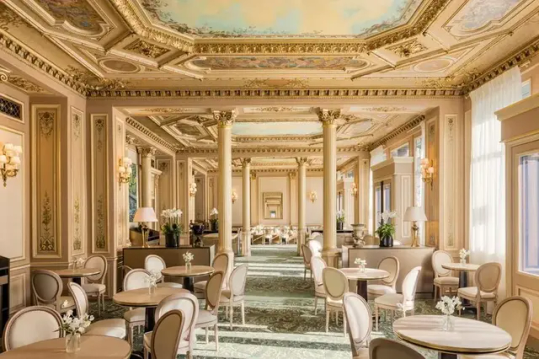
Where is it: 5 Pl. de l'Opéra, 75009 Paris, France
Café de la Paix is located in the 9th arrondissement of Paris, at the intersection of Boulevard des Capucines and Place de l'Opéra, in the building of the Le Grand Hotel. The hotel and cafe were opened in 1862 with the financial support of the Pereire brothers. The Café de la Paix gained its first international reputation in 1867, serving the International Exhibition.
The establishment, located next to the Opera Garnier, attracted many famous personalities. Pyotr Tchaikovsky, Jules Massenet, the Prince of Wales and Edward VII visited here. In 1896, Eugene Piroux held film screenings at the Café de la Paix, and later a radio studio was organized there.
Just like 150 years ago, today the restaurant is also very popular. Salads, hot dishes, snacks and desserts are served here.
Café du Monde, New Orleans
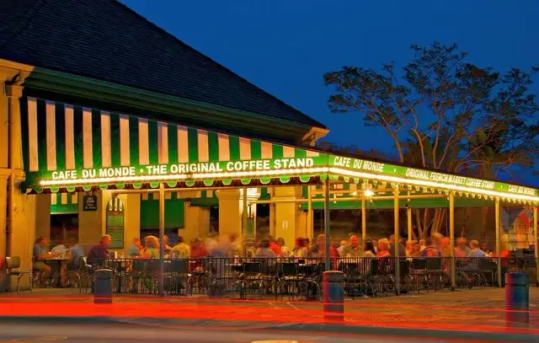
Location: 800 Decatur St, New Orleans, LA 70116, USA
Café du Monde is a true New Orleans landmark. The establishment has been in business since 1862 and always serves dark roasted chicory coffee, milk (regular or chocolate), fresh orange juice, hot chocolate and French donuts (beignets).
Cafe Landtmann, Vienna
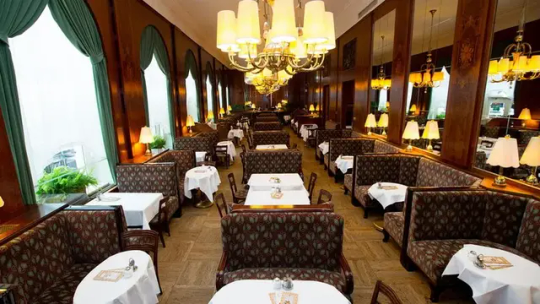
Location: Universitätsring 4, 1010 Wien, Austria
Café Landtmann is the oldest in Vienna. Guests began to be received here on October 1, 1873. Franz Landtmann dreamed of opening not just a coffee shop, but the most elegant place in Vienna. And he did everything for this - visitors were delighted with the innovative spirit of the establishment. Years passed, the owners changed, but this place was always popular among citizens and guests of the capital. In the 1970s, Cafe Landtmann was threatened with closure, but thanks to the efforts of the new owners, it was saved.
Baratti & Milano, Turin
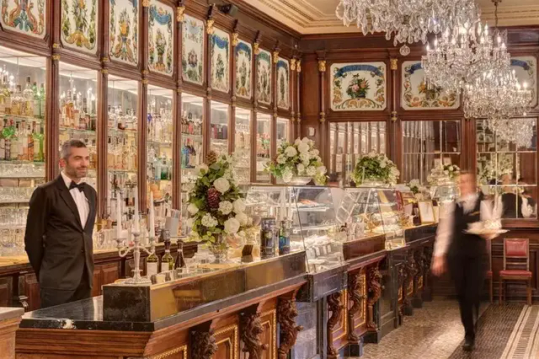
Location: Piazza Castello, 27, 10123 Torino TO, Italy
Caffè Baratti & Milano is a historic café in Turin, opened in 1875 in the central Galleria Subalpina. The establishment owes its name to two pastry chefs from Canavese: Ferdinando Baratti and Edoardo Milano. Soon after its opening, Caffè Baratti & Milano became a meeting place for the intelligentsia and the bourgeoisie. Its success has grown to the level of "official supplier of the Royal House".
The current appearance of the restaurant is the result of reconstruction in 1909. The room has a lot of marble, bronze, stucco, gilding and wide mirrors, which give this place a rich artistic appearance. The cafe was damaged during the Second World War, but was restored in 1948.
Caffè Baratti & Milano offers its visitors more than 20 types of coffee drinks, tea, light snacks, pastries and sweets.
Cafe Central, Vienna

Location: Herrengasse 14, 1010 Wien, Austria
The Central coffee shop is the most popular place in Vienna and is included in all must-see lists in this city. There are always long queues here - people come here to drink delicious coffee, eat strudel, listen to live music and just enjoy the atmosphere.
Cafe Central was founded by the Pakhi brothers in 1876. Over time, the establishment became a popular place where cultural representatives loved to come. His regular guests were Egon Friedel, Peter Altenberg, Adolf Loos, Alfred Adler, Leon Trotsky and others.
After World War II, Cafe Central closed. In 1975, the Ferstel Palace, where the establishment was located, was completely renovated. After this, the cafe reopened its doors to visitors.
Cafe Sacher Wien, Vienna
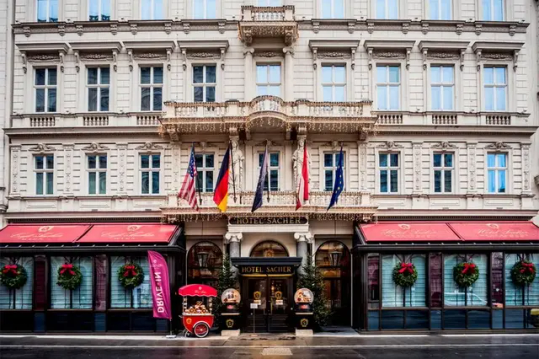
Location: Philharmoniker Str. 4, 1010 Wien, Austria
Another must-visit place in Vienna is the famous Sacher Wien café. After all, this is where they serve Sachertorte, made according to the classic recipe. In 1876, the Sacher family opened a hotel next to the Vienna Opera, which operated a café. It became a place where it was customary to have dinner before attending the opera - writers, artists and high-ranking officials met here.
Today, Cafe Sacher Wien is still very popular, as evidenced by the long queues.
Les Deux Magots, Paris
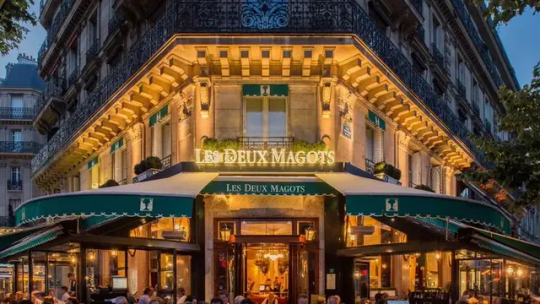
Where is it: 6 Pl. Saint-Germain des Pres, 75006 Paris, France
Les Deux Magots is a famous Parisian cafe located in the luxurious Saint-Germain-des-Prés quarter. It opened its doors to visitors in 1884. Originally a novelty store was located here, later coffee liqueurs were sold on this site. By 1914, the company was on the verge of bankruptcy, and was bought by Auguste Boulet for his cafe. His heirs still manage the establishment to this day.
Since then, Les Deux Magots has played an important role in the cultural life of the capital - writers, poets, artists and other intellectuals gathered here. Among the guests in the cafe one could meet Pablo Picasso, Bertolt Brecht, Albert Camus. The establishment has been described more than once in literary works and shown in films.
Cafe de Flore, Paris
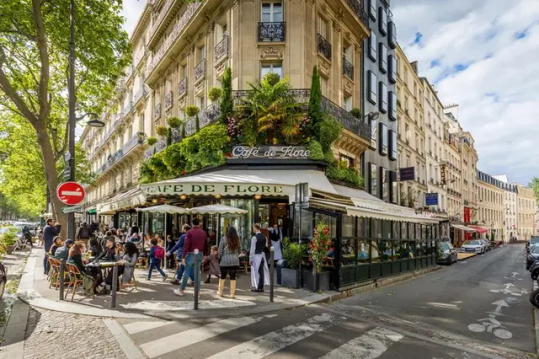
Location: 172 Bd Saint-Germain, 75006 Paris, France
Cafe de Flore was opened in 1887 in the 6th arrondissement of Paris, on the corner of Boulevard Saint-Germain and Rue Saint-Benoît. The interior of the establishment, in the classic Art Deco style, has remained virtually unchanged since World War II. Since its opening, intellectual audiences have met here. Among the famous guests at Cafe de Flore were Robert Desnos, Pablo Picasso, Georges Bataille. By the way, Charles Maurras wrote his book Au signe de Flore while sitting on the first floor of the cafe.
The restaurant's menu includes breakfasts, salads, cheeses, hot dishes, drinks and desserts.
Cafe Comercial, Madrid

Location: Glorieta de Bilbao, 7, 28004 Madrid, Spain
Café Comercial is located in the Glorieta de Bilbao square. It was founded by Antonio Gomez Fernandez in 1887.
Read the full article
1 note
·
View note
Text

🇩🇪 Berlin • O melhor da Alemanha
••••••••••••••
As origens do primeiro edifício religioso remontam ao século XIV, quando Frederico II de Brandenburgo, conhecido como Dente de Ferro, decidiu estabelecer sua residência na atual Ilha dos Museus e construir ali uma Capela da Corte. A atual construção da Catedral começou entre 1747 e 1750, na época de Frederico o Grande. A catedral, sob a direção de Johann Boumann, assumiu no início as características de um monumento barroco. O edifício foi então submetido a uma reforma classicista pelo arquiteto Karl Friedrich Schinkel entre 1817 e 1822 e finalmente em 1885 por Julius Raschdorff, que propôs a Frederick William IV um projeto que reconciliou os diferentes estilos.
Finalmente, a estrutura foi demolida a mando de Guilherme II, que ascendeu ao trono em 1888. Em 1893, o imperador autorizou a construção da atual catedral.
Durante a Segunda Guerra Mundial, a Catedral sofreu sérios danos devido aos bombardeios dos Aliados. Em 1975, a reconstrução do monumento foi iniciada pelas autoridades da RDA e só foi concluída em 1993, quatro anos após a queda do Muro. A Catedral hoje, reconhecível por sua esplêndida fachada barroca e sua imponente cúpula, é certamente um dos lugares mais importantes para se visitar em Berlim. No interior há muitas atrações para admirar, tanto de valor religioso como secular, incluindo a cripta Hohenzollerngruft, a cripta Hohenzollern, com cerca de 100 sarcófagos da dinastia. Também de grande interesse é a majestosa cúpula, da qual você pode desfrutar de uma vista espetacular do centro da cidade.
➖➖➖➖➖➖
✳️ Veja mais sobre a Alemanha🇩🇪
#wanderlust #instagram #instagood #instatravel #instatrip #travelgram #travel #traveller #berlin #berlinstagram #berlingram #ig_berlin #alexanderplatz #weilwirdichlieben #visitberlin #berlin365 #igersberlin #visit_berlin #berlincity #diestadtberlin #berlinlife #berlino #topberlinphoto #topgermanyphoto #germany #deutschland
1 note
·
View note
Photo
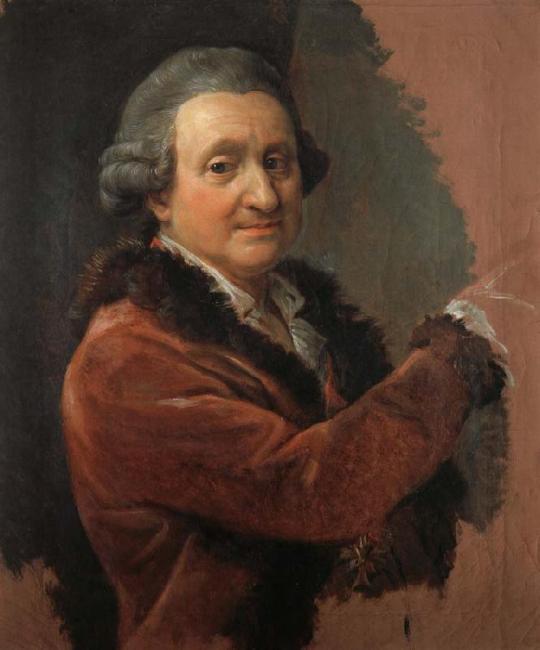

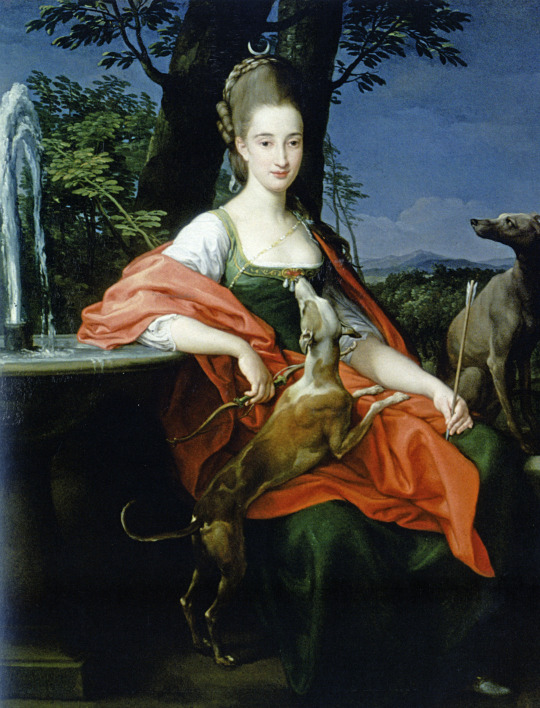
POMPEO GIROLAMO BATONI
On this day of 25th January, Pompeo Girolamo Batoni (25 January 1708 – 4 February 1787) was born in Lucca, Italy.
He was a painter who displayed a solid technical knowledge in his portrait work and in his numerous allegorical and mythological pictures. The foreign visitors travelling Italy and reaching Rome during their "Grand Tour" made the artist specialize in portraits. Batoni won international fame largely thanks to his customers of noble origin, kings and queens of Poland, Portugal, and Prussia, the Holy Roman Emperors Joseph II and Leopold II, Popes Benedict XIV, Clement XIII, Pius VI, Elector Karl Theodor of Bavaria, and many more.
Batoni's style took inspiration from French Rococo, Bolognese classicism, and the work of artists such as Nicolas Poussin, Claude Lorrain, and Raphael. As such Pompeo Batoni is considered a precursor of Neoclassicism.
Pompeo Batoni apprenticed with Agostino Masucci, Sebastiano Conca and/or Francesco Imperiali.
Batoni owed his first independent commission to a sudden storm, when Forte Gabrielli di Gubbio, count of Baccaresca took cover under the portico of the Palazzo dei Conservatori on the Capitoline Hill. Here the count met Batoni, who was drawing the ancient bas-reliefs and the paintings of the staircase of the palace. Gabrielli was so awed by his talent that he offered him to paint a new altarpiece for the chapel of his family in San Gregorio Magno al Celio, the Madonna on a Throne with Child and four Saints and Blesseds of the Gabrielli family
His notable followers include Vincenzo Camuccini, Angelo Banchero , Benigno Bossi , Paolo Girolamo Brusco , Antonio Cavallucci , Marco Cavicchia, Adamo Chiusole, Antonio Concioli , Domenico Conti Bazzani , Domenico Corvi , Felice Giani , Gregorio Giusti, Gaspare Landi , Nicola Antonio Monti , Giuseppe Pirovani , Pasquale Ciaramponi, Carlo Giuseppe Ratti, Henry Benbridge Maria Cosway Ivan Martos , Johann Gottlieb Puhlmann, and Johannes Wiedewelt .
The painter Benjamin West, while visiting Rome would complain that Italian artists "talked of nothing, looked at nothing but the works of Pompeo Batoni".
#pompeo girolamo batoni#pompeo batoni#master painters#famous painters#famous artists#art history#anniversary of artists#french rococo#bolognese classicism#neoclassicism
7 notes
·
View notes
Photo




libera me de sanguinibus, deus: a playlist for matt murdock
i. miserere mei, deus - gregorio allegri // deliver me from blood, o god // ii. are you hurting the one you love? - florence + the machine // are you hurting the one you love? you say you’ve found heaven but you can’t find god // iii. be thou my vision - salisbury cathedral choir // be thou my vision, o lord of my heart // iv. all these things that i’ve done - the killers // i want a meaning from the back of my broken hand // v. veni, veni emmanuel - libera // o come, o come emmanuel, and ransom captive israel // vi. new york minute - don henley // lying here in the darkness, hear the sirens wail, somebody going to emergency, somebody’s going to jail // vii. ave maria - johann sebastian bach // ora pro nobis, nobis peccatoribus, nunc et in hora, in hora mortis nostrae // viii. big god - florence + the machine // is it just part of the process? well, jesus christ, jesus christ, it hurts // ix. abide with me - oxford trinity choir // where is death’s sting? where, grave, thy victory? i triumph still if thou abide with me // x. nearer, my god, to thee - byu vocal point // nearer, my god, to thee, nearer to thee, e’en though it be a cross that raiseth me // xi. st jude - florence + the machine // the patron saint of the lost causes, we were lost before she started // xii. my song is love unknown - choir of king’s college, cambridge // love to the loveless shown, that they might lovely be // xiii. long & long - florence + the machine // is it too late to come on home? can a city forgive, i hear its sad song // xiv. kyrie - karl jenkins // lord have mercy, christ have mercy, lord have mercy // xv. seven devils - florence + the machine // i don’t want your money, i don’t want your crown, see i’ve come to burn your kingdom down // xvi. he who would valiant be - salisbury cathedral choir // no foes shall stay his might, though he with giants fight // xvii. 100 years - florence + the machine // lord don’t let me break this, let me hold it lightly, give me arms to pray with instead of ones that hold too tightly
#this is quite possibly the most emo thing i've ever made#also the most catholic#so much latin and so much florence it's insane#matt murdock#daredevil#marvel#cat.mp3
21 notes
·
View notes
Text
Gripsholm Castle

Around 1380, the Swedish Imperial Councillor and landowner Bo Jonsson, a member of the Grip family, who had acquired a number of estates in the Mariefred area, decided to build a castle here (strategically located on a small island).
During the following 150 years the castle had an eventful history. It was acquired by the Danish Queen Margarethe I, pledged to Count Hans von Ewersten (whose bailiff it quickly burned down in the course of the “Engelbrekt” uprising) and, after further changes of ownership, finally bequeathed to the nearby monastery, the Charterhouse Marienfred.
But about 30 years later it was again confiscated by the crown and in 1525 Gustav I. Wasa decided to move his permanent residence to Gripsholm. For this reason he had the castle extended and upgraded to a fortress.
The most significant change was the addition of the four mighty towers, which still characterise the face of the building today. One of them was eventually to serve Gustav as his residence.
After his death, the castle construction was continued by Erik XIV with long interruptions. Even then the castle was unsuitable as a defensive fortress; instead, it was used sporadically as a prison.
Between 1563 and 1567, for example, he had his brother Johann III and his wife Katharina Jagiellonica imprisoned here. In 1571, Johann locked up his deposed brother Erik and his family in the castle.
Finally, on 13 June 1573, Erik was taken out of captivity by Gustav Vasa’s son Karl, the future King Karl IX (officially because of necessary ceiling repairs).
It was also Charles who had the famous Imperial Hall built here, where today you can admire a full-length portrait of Gustav Wasa.
In the course of time, the palace was repeatedly altered and adapted to the prevailing spirit of the times, for example when Gustav III had the idea of building a private theatre here.
In the late 19th century, the last major restorations and alterations took place. However, when, in the course of these works, an attempt was made to reverse all the changes from around 1600 onwards, there was fierce protest and the project was dropped.
As a result, the castle was preserved as a masterpiece of architecture, reflecting several centuries of Swedish cultural history, and is now open to visitors.
0 notes
Text
GUSTAV IV ADOLF
King of Sweden
(born 1778 - died 1837)

pictured above is a portrait of the King of Sweden, by Johann Baptist Lampi (the Elder) from before 1830
-------------------- ~ -------------------- ~ --------------------
SERIES - Descendants of the Monarchs of Ireland: Gustav Adolf was a great-grandson of George II, King of Great Britain, the King of Ireland from 1727.
-------------------- ~ -------------------- ~ --------------------
GUSTAV ADOLF was born in 1778, at Stockholm Palace. He was the eldest son of Gustav III, King of Sweden and Princess Sophie Magdalene of Denmark.
Born a member of the Swedish line of the HOUSE OF HOLSTEIN-GOTTORP he was the CROWN PRINCE OF SWEDEN from birth.
When he was fourteen years old, his father suffered an assassination attempt and died in 1792. So, he unexpectedly ascended as GUSTAV IV, KING OF SWEDEN, under the Regency of his uncle Karl, Duke of Södermaland.
He married FRIEDERIKE DOROTHEA WILHELMINE in 1797, and they had five children. She was a Princess of Baden as one of the daughters of Karl Ludwig, Hereditary Prince of Baden, and Princess Amalie of Hesse-Darmstadt.
During his reign Sweden joined the Third and Fourth Coalitions alongside other European countries against Napoleón I, Emperor of the French.
The peace Treaty of Tilsit signed between France and Russia in 1807 became particularly damaging to Sweden and led to the Finnish War, in which Russia invaded Finland (a territory ruled by Sweden).
Swedish's bad decisions in the Finnish War would be his downfall, as by March 1809 a group of nobles orchestrated a coup to depose him.
These nobles seized him, imprisoned the Royal Family and put his uncle the Duke of Södermaland as head of the new provisional government.
By the end of the month he tried to ensure that his son Crown Prince Gustav would succeed to the throne and voluntarily abdicated. But the Riksdag (the Swedish Parliament) would not allow this to happen and ended up excluding his entire lineage from the Swedish line of succession.
In June the Duke of Södermaland was elected by the Parliament as King Karl XIII. Even though he was 60 years old, had no living legitimate children and his wife Princess Hedwig Elisabeth Charlotta of Holstein-Gottorp was to old to try to get pregnant and produce an heir.
As the deposed King he and his family left Sweden to exile in December. They first went to Denmark and then settled with his wife's family in the Grand Duchy of Baden, where his marriage deteriorated and they divorced in 1812.
Throughout his exile, he used the titles COUNT GOTTORP and DUKE OF HOLSTEIN-EUTIN.
Over twenty-eight years after his abdication, the former King of Sweden died aged 58, in 1837 at St. Gallen in the Swiss Confederation.
-------------------- ~ -------------------- ~ --------------------
At the time of his death a new Dynasty was already ruling Sweden, the Bernadottes. The new Monarch Karl XIV Johan had succeeded to the throne in 1818, as he had been elected as successor and was subsequently adopted by Gustav Adolf's uncle in 1810.
Having been the penultimate Holstein-Gottorp to rule in Sweden, the family's blood would only return to the Swedish Royal Family in the 20th century through his great-granddaughter Princess Viktoria of Baden, who married a Bernadotte and was the mother of King Gustav VI. Through them he is an ancestor of the current Swedish Monarch, Carl XVI Gustaf.
-------------------- ~ -------------------- ~ --------------------
Check my post on GUSTAV IV ADOLF's father and his connections to the Monarchs of Ireland!
His father was Gustav III, his predecessor as King of Sweden.
In a span of four generations GUSTAV IV ADOLF was related to the Monarchs of Ireland through his mother…
His mother was Princess Sophie Magdalene of Denmark.
His grandmother was Princesss Louisa of Great Britain.
His great-grandfather was George II, King of Great Britain - the King of Ireland between 1727-60.
#gustav adolf#gustav iv adolf#king gustav iv of sweden#king of sweden#house of holstein gottorp#holstein gottorp#swedish royals#swedish royal family#royals#royalty#monarchy#monarchies#royal history#swedish history#european history#world history#history#history lover#18th century#19th century#gustav iii#gustav iv#history with laura
0 notes
Text
Schloß Schönbrunn

La història del palau de Schönbrunn es remunta fins a l’edat mitjana, però s’esclareix a partir del segle XIV. Segons la llegenda, l'emperador Matthias d’Habsburg, que va regir el Sacre Imperi Romano-Germànic durant set anys al començament del segle XVII, va ser el responsable de l’actual nom.
L’efímer emperador es trobava als voltants del pavelló de caça de Katterburg quan hi va descobrir una font que li va semblar prou bonica com per identificar-la amb aquest nom: en alemany, Brunn vol dir font i schön bonic.
El que havia estat un pavelló de caça per afrofitar la riquesa cinegètica dels boscos que envoltaven Viena va evolucionar per convertir-se en residència d’estiu de la família reial austriaca, titulars indiscutits de la dignitat imperial germànica fins a la dissolució de l’Imperi, que va trobar la seva continuació en la unió entre Àustria i Hongria a començaments del segle XIX.
Mentre tant, Àustria s’involucrà en diverses guerres al llarg del segle XVII. A la dels Trenta Anys, quan es va veure com l’exèrcit suec arribava a les portes de Viena. Davant d’Hongria, que volia obtenir la seva independència efectiva. I contra l’Imperi Otomà, que culminà el 1683 amb el setge turc de Viena, que va acabar salvant-se gràcies a tropes poloneses i cosaques.
Però Schönbrunn, nom que va ser fet servir oficialment per primera vegada quan la vídua de l’emperador Ferdinand II, Eleonora Gonzaga, s’hi va instal·lar entre el 1637 i 1642, no es va salvar del setge. Va ser l’arquitecte Johann Bernhard Fischer von Erlach el que va intervenir en aquesta transformació, encarregada per l’emperador Leopold I, contribuint significativament a l’aspecte actual.
Fischer von Erlach va ser un dels arquitectes més prolífics del barroc austriac i seva és la concepció de la Karlskirche, a Viena, fàcilment reconeguda per les dues sinuoses columnes que emmarquen la façana d’aquesta església dedicada a Sant Carles Borromeu. Schönbrunn va romandre inacabat a causa de la mort sobtada de Joseph I (1711) i fou la residència de la seva vídua Wilhelmine Amalia.
El 1728 l'emperador Karl VI va reprendre el relleu a les obres i posteriorment el va donar a la seva filla Maria Theresia. L’emperadriu va encarregar l’adaptació a l’estil rococó a Nikolaus Pacassi i hi va establir la seva residència d’estiu.
El primer que va ordenar va ser l'expansió dels apartaments imperials a l'ala est amb sales d’audiència i salons per a Maria Theresia i el seu consort, Franz Stefan von Lothringen, que ja es pogueren ocupar el 1746. La coronació del marit de Maria Theresia com a emperador romano-germànic a Frankfurt el 1745 va donar un nou impuls a Schönbrunn per convertir-se en residència imperial d’estiu, amb tot un seguit de nous edificis.
Una de les característiques del palau és el seu color groc, una tonalitat identificada amb el mateix Schönbrunn com una de les seves especificitats més singulars. Però el palau mateix no és un sol edifici. El seu immens parc i els boscos que l’emmarcan donen cabuda a d’altres peces úniques: l’hivernacle Palmenhaus de plantes exòtiques, ruïnes romanes, fonts monumentals, un zoològic… Tot presidit per la Gloriette que s’alça al lloc més alt del parc.
No va ser fins a finals del segle XIX que l’emperador Franz Joseph, que va néixer i va morir a Schönbrunn, va viure-hi tot l'any i, amb ell, una de les residents més famoses del palau, la princesa Elisabeth de Wittelsbach, duquessa de Baviera, més coneguda com a Sissi.
1 note
·
View note
Text
The Midheaven: How You Will Be Remembered
The Midheaven (MC) is commonly thought to describe one’s career path. Although this is a decent indicator of one’s overall path, it can be hard to relate to a specific career so early in one’s life. So, if you don’t relate to your Midheaven like, “Oh, you have a MC in Aries, so you’re probably going to be a police officer, solider, or athlete" then maybe try thinking of the Midheaven as how you will be remembered or what you are generally associated with. (Always trust your dominant sign to describe you the most- *a post similar to this coming soon) ✨No matter what career you decide, you will be remembered by your peers, co-workers, friends, and family by traits from the sign, aspects*, and planets* bestowed upon your 10th House.✨
♈ Aries MC: will be remembered for their courage, boldness, intimidating/unsettling nature, and/or originality. (ex. Stephen King, Meryl Streep, Kanye West, Joan of Arc, Bill Gates, Angelina Jolie, Madalyn Murry O'Hair, Pablo Picasso, Rachel Maddow, Will Smith, Franz Kafka, Tyra Banks, Aleister Crowley, Tina Fey, Francisco de Goya, Julia Roberts, Chris Farley, Joseph Goebbels, Marvin Gaye, Iggy Pop, Kate Moss, Alfred Hitchcock, George Wallace, Hank Williams, Ayn Rand, Rob Zombie, Alexandre Dumas, John Steinbeck, Anne Frank, Twiggy, Jack Black, William Blake, Celine Dion, Galileo Galilei, Al Gore, Emmylou Harris, Las Vegas-Nevada, Manhattan-New York)
♉ Taurus MC: will be remembered for their extravagant style or possessions, their values, and/or “diva” attitude. (ex. Henry VIII, Andy Warhol, Marilyn Monroe, Tina Turner, Pope Francis, Jackie Robinson, Selena Gomez, Drake, Donald Trump, Freddie Mercury, Agatha Christie, Muhammad Ali, Frida Kahlo, O. J. Simpson, Justin Timberlake, Marlene Dietrich, Malala Yousafzai, Christopher Columbus, Michael Bay, Luciano Pavarotti, Nicole Richie, Woody Allen, Marilyn Manson, Maya Angelou, Martin Scorsese, Bernie Madoff, Ringo, Josephine Baker, Andrew Lloyd Webber, Sarah Palin, Josh Groban, Chris Brown, Mary Kate & Ashley Olsen, Norway)
♊ Gemini MC: will be remembered for/through words (writing, phrase, acting, thoughts, speech), their cleverness, and/or mental/emotional detachment. (ex. Jean-Jaques Rousseau, Albert Camus, Madonna, J.R.R. Tolkein, Donna Summer, Wolfgang Amadeus Mozart, Chelsea Handler, Alex Trebek, Kurt Cobain, Julie Andrews, Oscar Wilde, Jay-Z, Richard Nixon, Harriet Beecher Stowe, Tom Hanks, Kris Jenner, Walt Disney, Miss Cleo, Mark Zuckerberg, Steve Jobs, Hugh Hefner, Lizzie Borden, Jane Austen, Charles Dickens, Kathy Bates, Winston Churchill, Melissa Ethridge, Ernest Hemingway, Margaret Mitchell, Paul Simon, Greece, Tokyo-Japan)
♋ Cancer MC: will be remembered for their emotional impact, sensitivity, and/or parental care/control. (ex. Beyoncé, Matamha Gandhi, John F. Kennedy, Venus Williams, Britney Spears, Arthur Rimbaud, Elizabeth Warren, Denzel Washington, Jeffery Dahmer, Sun Yet-sen, Bob Hope, Stevie Wonder, Anderson Cooper, Cat Stevens, Anna Nicole Smith, Joe Jonas, Rock Hudson, Alice Cooper, Woodrow Wilson, Barbara Walters, T. S. Elliot, Coretta Scott King, Albert Schweitzer, Ted Cruz, Monica Lewinsky, H.P. Lovecraft, Anaïs Nin, Katie Couric, Ralph Waldo Emerson, Carole King, Neil Diamond, Harper Lee, Giacomo Puccini, Sidney Poitier, September 11 attacks, United Kingdom)
♌ Leo MC: will be remembered for their theatrics, arrogance/vanity, power, and/or regality. (ex. Grace Kelly, Prince, Isaac Newton, Adolf Hitler, Katy Perry, Charlie Chaplin, Aretha Franklin, Sigmund Freud, Jacqueline Onassis-Kennedy, Stanley Kubrick, Courtney Love, Mark Twain, Chaka Khan, Napoleon Bonaparte, Kathy Griffin, Jim Carrey, Alfred Nobel, Eric Clapton, Annie Oakley, Martha Stewart, Divine, Louis Pasteur, Robin Williams, Ludwig Van Beethoven, Chuck Berry, Vladimir Putin, Clint Eastwood, Missy Elliot, Frank Sinatra, Mel B, Edgar Allan Poe, Los Angeles-CA)
♍ Virgo MC: will be remembered for their scandals/controversy, never-ending toil, physicality/health and/or attention to detail. (ex. Hillary Clinton, Bruce Lee, Kim Kardashian, Ellen DeGeneres, Brad Pitt, Nelson Mandela, Bette Davis, Justin Bieber, Elvis Presley, Erykah Badu, Jimmy Page, Eartha Kitt, Leonardo de Vinci, Bob Marley, Joan Crawford, Margaret Thatcher, Eminem, Friedrich Nietzsche, David Lynch, Chaz Bono, Marlon Brando, Björk, Ozzy Osborne, Emily Brontë, Bernie Sanders, Georgia O'Keeffe, Diana Ross, Kahlil Gibran, Russia, United States)
♎ Libra MC: will be remembered for their inner/outer beauty, adaptability, and/or desire for or appearance of stability. (ex. Elton John, Jane Goodall, Malcolm X, Coco Channel, Kylie Jenner, Ronald Reagan, Princess Diana, Michelangelo, Oprah Winfrey, Bob Dylan, Winona Ryder, Jimi Hendrix, Mother Teresa, Elizabeth Taylor, Cristiano Ronaldo, Angela Merkel, Tom Brokaw, Alan Watts, Charles Darwin, Brigitte Bardot, Patti Smith, Chuck Norris, Linda Lovelace, Ray Charles, Lionel Messi, Eleanor Roosevelt, Lewis Carroll, Noam Chomsky, Lucille Ball, Venice-Italy)
♏ Scorpio MC: will be remembered for their physical attractiveness, taboo activities/topics, and/or natural talent. (ex. James Joyce, Billie Holiday, Taylor Swift, Barack Obama, Carrie Fisher, Jim Morrison, Selena, F. Scott Fitzgerald, Queen Elizabeth II, Ariana Grande, Marie Curie, Anthony Hopkins, René Descartes, Nina Simone, Willem Dafoe, Paul Newman, Mariska Hargitay, Thomas Jefferson, Ray Bradbury, Joseph Stalin, Larry King, Duke Ellington, Joan Jett, Buddy Holly, Megan Fox, Johnny Knoxville, Daniel Day-Lewis, Gwen Stefani, Francis Ford Coppola, Sophia Loren, Marcus Aurelius, China)
♐ Sagittarius MC: will be remembered for their joviality, reckless/wild free spirit, sense of humor, and/or philosophy/spirituality. (ex. Al Capone, Deepok Chopra, Shia LaBeouf, Audrey Hepburn, Harvey Milk, Johnny Cash, David Bowie, Bettie Page, Pablo Neruda, J. K. Rowling, Christina Aguilera, Michael Jackson, Henry David Thoreau, Adele, Janis Joplin, Maximilien Robespierre, Ellen Pompeo, Whitney Houston, Paul McCartney, Evel Knievel, Bruno Mars, Jimmy Fallon, Peggy Lipton, Karl Marx, George Takei, Ryan Gosling, Whoopi Goldberg, Vincent Price, Rio de Janeiro-Brazil)
♑ Capricorn MC: will be remembered for their accomplishments/legacy, conquering of odds, and/or persistence. (ex. Martin Luther King Jr., George Washington, Rihanna, Isadora Duncan, Benjamin Franklin, James Dean, Nikola Tesla, John D. Rockefeller, Serena Williams, Joan Baez, Snoop Dogg, Alexander the Great, Barbara Streisand, Ron Howard, Stevie Nicks, Bette Midler, Joan Rivers, Immanuel Kant, Queen Latifah, Johann Sebastian Bach, Walt Whitman, Che Guevara, Liza Minnelli, Amelia Earhart, Mariah Carey, John Lennon, George Lucas, Donatella Versace, Louis Armstrong, Pakistan)
♒ Aquarius MC: will be remembered for their rebellious nature, involvement in a social organization/group, and/or unpredictability. (ex. Miley Cyrus, Tim Burton, Voltaire, Mick Jagger, Carl Sagan, Rita Hayworth, Neil Armstrong, Amy Winehouse, Pamela Anderson, Carlos Santana, Edward Snowden, Leo Tolstoy, Mae West, Orson Welles, Charlie Sheen, Eva Peron, Miles Davis, Bruce Springsteen, Johann Kepler, Suddam Hussein, Ruby Rose, Gerard Way, Helen Mirren, Howard Stern, Arthur Conan Doyle, Mary Shelley, George R. R. Martin, Kristen Stewart, Jean Piaget, Ronda Rousey, Willow Smith, Florida, India)
♓ Pisces MC: will be remembered for their delusional optimism, supernatural success, and/or they are often idolized. (ex. Vincent Van Gogh, Albert Einstein, Irene Cara, Cher, Salvador Dalí, William Shakespeare, Edie Sedgwick, Fidel Castro, Lady Gaga, Dalai Lama XIV, Steven Spielberg, George Michael, Marie Antoinette, RuPaul, Judy Garland, Michael Phelps, Sally Ride, John Cena, William Faulkner, Victoria Beckham, Lee Harvey Oswald, Douglas Adams, Jean Renoir, Buzz Aldrin, Arnold Schwarzenegger, Farrah Fawcett, Osama bin Laden, Sam Cooke, Michael Jordan, Switzerland, North Korea)
#midheaven#astrology#birth chart#natal chart#celebrity#10th house#traits#mine#career#mc#aries midheaven#taurus midheaven#gemini midheaven#cancer midheaven#leo midheaven#virgo midheaven#libra midheaven#scorpio midheaven#sagittarius midheaven#capricorn midheaven#aquarius midheaven#pisces midheaven
6K notes
·
View notes
Text
Francis II.: What are you talking about Jean? You love it here in our coalition!
Bernadotte: I'm not sure I do, it could very well just be Stockholm syndrome.
27 notes
·
View notes
Photo


Franz Joseph I or Francis Joseph I (Franz Joseph Karl; 18 August 1830 – 21 November 1916) was Emperor of Austria, King of Hungary, and monarch of many other states of the Austro-Hungarian Empire, from 2 December 1848 to his death.[1] From 1 May 1850 to 24 August 1866 he was also President of the German Confederation. He was the longest-reigning Emperor of Austria and King of Hungary, as well as the third-longest-reigning monarch of any country in European history, after Louis XIV of France and Johann II of Liechtenstein.[2]
In December 1848, Emperor Ferdinand abdicated the throne at Olomouc, as part of Minister President Felix zu Schwarzenberg's plan to end the Revolutions of 1848 in Hungary. This allowed Ferdinand's nephew Franz Joseph to accede to the throne. Largely considered to be a reactionary, Franz Joseph spent his early reign resisting constitutionalism in his domains. The Austrian Empire was forced to cede its influence over Tuscany and most of its claim to Lombardy–Venetia to the Kingdom of Piedmont-Sardinia, following the Second Italian War of Independence in 1859 and the Third Italian War of Independence in 1866. Although Franz Joseph ceded no territory to the Kingdom of Prussia after the Austrian defeat in the Austro-Prussian War, the Peace of Prague (23 August 1866) settled the German question in favour of Prussia, which prevented the Unification of Germany from occurring under the House of Habsburg.[3]
Franz Joseph was troubled by nationalism during his entire reign. He concluded the Austro-Hungarian Compromise of 1867, which granted greater autonomy to Hungary and transformed the Austrian Empire into the Dual Monarchy of Austria-Hungary. He ruled peacefully for the next 45 years, but personally suffered the tragedies of the execution of his brother, the Emperor Maximilian of Mexico in 1867, the suicide of his only son and heir, Crown Prince Rudolf, in 1889, and the assassination of his wife, Empress Elisabeth, in 1898.
After the Austro-Prussian War, Austria-Hungary turned its attention to the Balkans, which was a hotspot of international tension because of conflicting interests with the Russian Empire. The Bosnian Crisis was a result of Franz Joseph's annexation of Bosnia and Herzegovina in 1908, which had been occupied by his troops since the Congress of Berlin (1878).
On 28 June 1914, the assassination of his nephew, Archduke Franz Ferdinand, in Sarajevo resulted in Austria-Hungary's declaration of war against the Kingdom of Serbia, which was Russia's ally. That activated a system of alliances which resulted in World War I.
Franz Joseph died on 21 November 1916, after ruling his domains for almost 68 years as one of the longest-reigning monarchs in modern history. He was succeeded by his grandnephew Charles.
https://en.wikipedia.org/wiki/Franz_Joseph_I_of_Austria
0 notes
Text
20 Most Important Figures in History
Who's Biggest? And we are not talking about Porn actors.
Who is bigger in terms of historical significance? Wether their actions or words did good or wrong, is not relevant for history, what it is relevant is their influence to shape, change and shake the world they lived in. Obviously, this kind of rank is always subjective, and one can argue the order or why I have included that person and not that other one, and so on and so forth, but I am pretty sure most of you will agree with the following list.
1. Jesus
2. Napoleon
3. Muhammad (the prophet, not the boxer)
4. William Shakespeare
5. Abraham Lincoln
6. George Washington
7. Adolf Hitler
8. Aristotle
9. Alexander the Great (he was really great)
10. Thomas Jefferson
11. Henry VIII of England
12. Charles Darwin
13. Elizabeth I of England (not the modern one)
14. Karl Marx
15. Genghis Khan
16. Queen Victoria
17. Martin Luther King
18. Joseph Stalin
19. Albert Einstein
20. Christopher Colombus
21. Isaac Newton
22. Charlemagne
23. Theodore Roosevelt
24. Wolgang Amadeus Mozart
25. Plato
26. Louis XIV of France
27. Ludwig van Beethoven
28. Leonardo da Vinci
29. Augustus
30. Benjamin Franklin
31. Winston Churchill
32. Thomas Edison
33. Friedrich Nietzsche
34. Sigmund Freud
35. Alexander Hamilton
36. Gandhi
37. Galileo Galilei
38. Johann Sebastian Bach
39. Oliver Cromwell
40. Buddha
41. Adam Smith
42. Immanuel Kant
43. James Cook
44. John Adams
45. Voltaire
46. Socrates
47. Copernicus
48. Lenin
49. Jean-Jacques Rousseau
50. Michelangelo
51. Philip II of Spain
52. Thomas Aquinas
53. Nikola Tesla
54. Joan of Arc
55. Descartes
#biography of jesus#biography of napoleon#biography of muhammad#biography of shakespeare#biography of abraham lincoln#biography of george washington#biography of hitler#biography of aristotle#biography of alexander the great#biography of thomas jefferson#biography of henry viii of england#biography of charles darwin#biography of elizabeth i of england#biography of karl marx#biography of genghis khan#biography of queen victoria#biography of martin luther king#biography of lenin#biography of albert einstein#biography of christopher colombus#biography of isaac newton#biography of charlemagne#biography of theodore roosevelt#biography of wolgang amadeus mozart#biography of plato#biography louis xiv of france#biography of ludwig van beethoven#biography of leonardo da vinci#biography of augustus#biography of benjamin franklin
2 notes
·
View notes
Text
Illuminati founder Adam Weishaupt
Johann Adam Weishaupt pronounced vice-how-pt, 6 February 1748 – 18 November 1830) was a German philosopher, professor, and founder of the Order of the Illuminati, a secret society.
Adam Weishaupt was born on 6 February 1748 in Ingolstadt in the Electorate of Bavaria. Weishaupt's father Johann Georg Weishaupt (1717–1753) died[5] when Adam was five years old.
After his father's death he came under the tutelage of his godfather Johann Adam Freiherr von Ickstatt who, like his father, was a professor of law at the University of Ingolstadt.
Ickstatt was a proponent of the philosophy of Christian Wolff and of the Enlightenment,[8] and he influenced the young Weishaupt with his rationalism. Weishaupt began his formal education at age seven at a Jesuit school.
He later enrolled at the University of Ingolstadt and graduated in 1768[9] at age 20 with a doctorate of law. In 1772 he became a professor of law.
The following year he married Afra Sausenhofer of Eichstätt. After Pope Clement XIV’s suppression of the Society of Jesus in 1773, Weishaupt became a professor of canon law, a position that was held exclusively by the Jesuits until that time.
In 1775 Weishaupt was introduced to the empirical philosophy of Johann Georg Heinrich Feder of the University of Göttingen. Both Feder and Weishaupt would later become opponents of Kantian idealism.
On 1 May 1776 Johann Adam Weishaupt founded the "Illuminati" in the Electorate of Bavaria. He adopted the name of "Brother Spartacus" within the order.
Even encyclopedia references vary on the goal of the order, such as New Advent saying the Order was not egalitarian or democratic internally, but sought to promote the doctrines of equality and freedom throughout society; while others like Collier's have said the aim was to combat religion and foster rationalism in its place.
The actual character of the society was an elaborate network of spies and counter-spies. Each isolated cell of initiates reported to a superior, whom they did not know: a party structure that was effectively adopted by some later groups.
Weishaupt was initiated into the Masonic lodge "Theodor zum guten Rath", at Munich in 1777. His project of "illumination, enlightening the understanding by the sun of reason, which will dispel the clouds of superstition and of prejudice" was an unwelcome reform.
He used Freemasonry to recruit for his own quasi-masonic society, with the goal of "perfecting human nature" through re-education to achieve a communal state with nature, freed of government and organized religion. Presenting their own system as pure masonry, Weishaupt and Adolph Freiherr Knigge, who organised his ritual structure, greatly expanded the secret organisation.
Contrary to Immanuel Kant's famous dictum that Enlightenment (and Weishaupt's Order was in some respects an expression of the Enlightenment Movement) was the passage by man out of his 'self-imposed immaturity' through daring to 'make use of his own reason, without the guidance of another,'
Weishaupt's Order of Illuminati prescribed in great detail everything which the members had obediently to read and think, so that Dr. Wolfgang Riedel has commented that this approach to illumination or enlightenment constituted a degradation and twisting of the Kantian principle of Enlightenment.
Riedel writes: 'The independence of thought and judgement required by Kant ... was specifically prevented by the Order of the Illuminati's rules and regulations. Enlightenment takes place here, if it takes place at all, precisely under the direction of another, namely under that of the "Superiors" [of the Order].
Weishaupt's radical rationalism and vocabulary were not likely to succeed. Writings that were intercepted in 1784 were interpreted as seditious, and the Society was banned by the government of Karl Theodor, Elector of Bavaria, in 1784. Weishaupt lost his position at the University of Ingolstadt and fled Bavaria
Join the Illuminati https://www.howtojoinilluminati.co.za/
Illuminati symbols https://www.howtojoinilluminati.co.za/symbols-signs-illuminati.html
History of the Illuminati https://www.howtojoinilluminati.co.za/history-of-illuminati.html
0 notes
Text
The 100 A Ranking Of The Most Influential Persons In History By Michael H. Hart
Book Name
The 100 A Ranking Of The Most Influential Persons In History By Michael H. Hart
Author Michael Hart’s
Book Publishers A Citadel Press Book Carol Publishing Group
Publish Date 2000
Language. English
Category English Novel History
Book Code 238
Pages 591
Rs 1200
Book Quality Black Paper
Whatsapp +92312-9775152
E-mail [email protected]
INTRODUCTION
In his book Letters on the English, Voltaire relates that during
his stay in England, in 1726, he overheard some learned men dis-
cussing the question: who was the greatest man-Caesar, Alex-
ander, Tamerlane, or Cromwell? One speaker maintained that
Sir Isaac Newton was beyond a doubt the greatest man. Voltaire
agreed with this judgment, for: "It is to him who masters our
minds by the force of truth, and not to those who enslave them
by violence, that we owe our reverence."
Whether Voltaire was truly convinced that Sir Isaac New-
ton was the greatest man who ever lived or was simply trying to
make a philosophical point, the anecdote raises an interesting
question: of the billions of human beings who have populated the
earth, which persons have most influenced the course of history?
This book presents my own answer to that question, my list
of the 100 persons in history whom I believe to have been the
most influential. I must emphasize that this is a list of the most
influential persons in history, not a list of the greatest. For exam-
ple, there is room in my list for an enormously influential, wick-
ed, and heartless man like Stalin, but no place at all for the saint-
ly Mother Cabrini.
This book is solely involved with the question of who were
the 100 persons \vho had the greatest effect on history and on the
course of the world. I have ranked these 100 persons in order of
importance: that is, according to the total amount of influence
that each of them had on human history and on the everyday
lives of other human beings. Such a group of exceptional people,
whether noble or reprehensible, famous or obscure, flamboyant
or modest, cannot fail to be interesting; they are the people who
have shaped our lives and formed our world.
About
A list of the one hundred most influential people in history features descriptions of the careers, contributions, and accomplishments of the political and religious leaders, inventors, writers, artists, and others who changed the course of history. Simultaneous.
In 1978, when Michael Hart’s controversial book The 100 was first published, critics objected that Hart had the nerve not only to select who he thought were the most influential people in history, but also to rank them according to their importance. Needless to say, the critics were wrong, and to date more than 60,000 copies of the book have been sold. Hart believed that in the intervening years the influence of some of his original selections had grown or lessened and that new names loomed large on the world stage. Thus, the publications of this revised and updated edition of The 100.
As before, Hart's yardstick is influence: not the greatest people, but the most influential, the people who swayed the destinies of millions of human beings, determined the rise and fall of civilizations, changed the course of history. With incisive biographies, Hart describes their careers and contributions. Explaining his ratings, he presents a new perspective on history, gathering together the vital facts about the world's greatest religious and political leaders, inventors, writers, philosophers, explorers, artists, and innovators—from Asoka to Zoroaster. Most of the biographies are accompanied by photographs or sketches. Hart's selections may be surprising to some. Neither Jesus nor Marx, but Muhammad, is designated as the most influential person in human history. The writer's arguments may challenge and perhaps convince readers, but whether or not they agree with him, his manner of ranking is both informative and entertaining. The 100, revised and updated, is truly a monumental work. It promises to be just as controversial, just as thought-provoking, and just as successful as its predecessor—a perfect addition to any history or philosophy reference section.
LIST OF ILLUSTRATIONS
Mecca, the holy city of Islam; the black building at
center is the Kaaba, the sanctuary that houses
the black stone.
M uhmnmad and the Arab conquests (map).
Moslem crusaders under Muhammad conquer in
Allah's name.
Isaac Newton.
N e\vton analyzes a ray of light.
Jesus Christ.
ReIn brandt' s "Hundred Guilder Print" of Christ
preaching.
Buddha.
The belfry of a Japanese Buddhist temple.
"Buddha's Return from Heaven," by N anda Lal Bose.
Confucius.
The legendary meeting of Confucius with Lao Tzu.
St. Paul.
Detail of Michelangelo's fresco, "The Conversion of
Saint Paul," in the Vatican.
Christian pilgrims march in a Good Friday procession
on the Via Dolorosa in Jerusalem.
Ts'ai Lun.
Process of papernlaking.
Johann Gutenberg.
Gutenberg and friends examine the first printed page.
A page from an original Gutenberg Bible. 45
Christopher Columbus. 47
"Columbus before Isabella," by Vacslav Brozik. 48
The Nina, the Pinta, and the Santa Maria sail to the
New World. 50
"The Landing of Columbus," by John Vanderlyn. 51
Albert Einstein. 52
The atomic bomb explodes at Hiroshima, August 6,
1945. 56
Einstein discusses his theories. 59
Louis Pasteur. 60
Pasteur in his laboratory. 62
Galileo Galilei. 64
Illustration of Galilean law of leverage from Galileo's
physics textbook Mathematical Discourses and
Demonstrations. 65
Galileo's telescope. 66
The Leaning Tower of Pisa from which Galileo
supposedly demonstrated the laws of falling
bodies. 68
Aristotle. 70
Portrait of Aristotle by Raphael, detail from "The
School of Athens." 72
Aristotle and his pupil, Alexander. 74
Euclid. 75
Diagram from a Euclidian geometric theorem. 78
Statue of Moses, by Michelangelo. 79
"Moses with the Ten Commandments," by Guido
Reni. 81 List of Illustrations xiii
Charles Darwin. 82
Beagle Channel was named after Darwin's ship "The
Beagle." 86
Great Wall of China. 87
Augustus Caesar. 92
The Roman Empire at the death of Augustus (map). 94
Statue of Augustus Caesar at the Vatican. 98
Nicolaus Copernicus. 99
The Copernican system of the universe. 101
Antoine Laurent Lavoisier. 103
Lavoisier in his laboratory at the Royal Arsenal. 106
Constantine the Great. 107
"Constantine Fighting the Lion," from Constantine
tapestry designed by Pietro Da Cortona. 110
James Watt. III
Watt's double-acting steam engine, 1769. 113
Watt, as a boy, notices the condensation of steam. 114
Michael Faraday. 115
Faraday lectures at the Royal Institution on December
27, 1855. 118
James Clerk Maxwell. 119
Maxwell's equations are the basic laws of electricity
and magnetism. 121
Martin Luther. 123
Luther nails the Ninety-five Theses to the door of the
church at Wittenberg. 125
"Luther before the Diet of Worms," by E. Delperee. 127
George Washington. 129 xiv List of Illustrations
Karl Marx.
133
Chinese citizens at a cadre school in Beijing receive
instructions in Marxism. 136
Orville and Wilbur Wright. 138
The Wright brothers' original byplane. 140
The historic first flight of the Wright brothers' airplane
at Kitty Hawk. 142
Genghis Khan. 144
The Mongol conquests (map). 147
Adam Smith. 148
Smith is commemorated on the Scots penny. 151
Portrait of Edward de Vere (attributed to Marcus
Gheeraedts). 152
Hedingham Castle, the birthplace and childhood home
of Edward de Vere. 157
Letter written (in French) by Edward de Vere when
he was 13 years old. 161
John Dalton. 170
Dalton's table of atomic weights. 172
Alexander the Great. 174
The Empire of Alexander the Great (map). 177
Alexander on horseback, detail from "The Battle of
Alexander," mosaic at Pompei from the 2nd
century, B. C. 179
Napoleon Bonaparte. 181
Napoleon before the Sphinx CL'Oedipe") by J. L.
Gerome. 183
Napoleon at the Battle of Waterloo. 187
Thomas Edison. 188 List of Illustrations xv
Edison in his laboratory at Menlo Park. 191
Antony van Leeuwenhoek. 192
William T. G. Morton 195
Morton anesthetizes a patient. 198
With this glass container, Morton first administered
sulphuric ether to a patient in 1846. 200
Guglielmo Nlarconi. 201
Marconi at his telegraph machine. 202
Marconi in his floating laboratory, the yacht "Elettra." 203
Adolf Hitler. 205
Scene at Buchenwald. 209
Nazi soldiers, 1933. 211
Plato. 213
Oliver Cromwell. 217
Cromwell refuses the crown of England. 221
Alexander Graham Bell. 222
Bell opens the telephone line between New York and
Chicago in 1892. 224
Alexander Fleming. 225
John Locke. 228
Ludwig van Beethoven. 232
An original manuscript by Ludwig van Beethoven. 234
Werner Heisenberg. 236
Louis Daguerre. 240
The official Daguerre camera produced by Daguerre's
brother-in-law, Alphonse Giroux, carried a label
that says: "No apparatus guaranteed if it does not
bear the signature of M. Daguerre and the seal of
M. Giroux." 243 xvi
SiInon Bolivar.
Rene Descartes.
List of Illustrations
Title page from the first edition of Discourse on
244
248
Method, 1637. 253
Michelangelo. 254
The "David," in the Accademia in Florence. 255
The "Piehl," in the Vatican in Rome. 256
"God Dividing the Waters from the Earth," section of
the Sistine Chapel ceiling. 257
Pope Urban II incites Crusaders to recapture the Holy
Land. 258
Mosque in Cairo named after 'u mar ibn al-Khattab. 261
Arab expansion under 'Umar ibn al-Khattab (map). 262
Asoka issued edicts on stone pillars, such as this
Asokan pillar at Lauriya-N andangarh. 266
Augustine disputes with Manichaeans. 268
Augustine dictates to a scribe. 271
William Harvey. 273
Harvey explains his ideas to Charles 1. 275
Illustrations from William Harvey's book On the
Movement of the Heart and Blood in Animals. 276
Ernest Rutherford. 277
John Calvin. 281
Monument in Geneva commemorating the
Reformation. 284
Gregor Mendel. 286
The genetic patterns of the flower mirabilis jalapa. 289
Max Planck. 291
Joseph Lister. 294 List of Illustrations xvii
Nikolaus August Otto. 297
Otto's engine was employed by automobile pioneers
Gottlieb Daimler and Karl Benz. 301
The original "Benzine Buggy." 301
Francisco Pizarro. 303
Pizarro's audience with Charles V before em barking
for Peru. 306
Hernando Cortes. 309
Cortes and Montezuma meet. 313
Thomas Jefferson. 315
Jefferson's home in Charlottesville, Virginia-the
historic Monticello-was built from his own
designs. 319
Queen Isabella I. 322
Joseph Stalin. 328
Scene from one of the spectacular Russian treason
trials of the thirties, which established Stalin's
reputation as a tyrant. 331
Stalin meets with M.l. Kalinin, president of the
Soviet Union, 1923-1946. 335
Julius Caesar. 336
The Ides of March: the assassination of Julius Caesar. 339
William the Conqueror. 341
William the Conqueror at the Battle of Hastings. 345
The first known painting of the Battle of Hastings. 347
Sigmund Freud. 348
Edward Jenner. 351
Jenner administers the first vaccination. 353
Wilhelm Conrad Rontgen. 355 xviii List of Illustrations
X-rays have facilitated great advances in dentistry. 357
Johann Sebastian Bach. 359
A page from the score of the "Prelude and Fugue in
B-Minor," written by J. S. Bach. 362
Lao Tzu. 363
Taoist family sacrifices to the harvest moon. 365
Voltaire. 367
Voltaire's funeral. 372
Johannes Kepler. 373
Enrico Fermi. 377
Leonhard Euler. 381
J ean-Jacques Rousseau. 385
An etching of Rousseau by N audet. 388
N iccolo Machiavelli. 390
Bust of Niccolo Machiavelli by an unknown Florentine
sculptor. 393
Thomas Malthus. 395
John F. Kennedy. 399
On July 20, 1969, the Apollo II astronauts left this
footstep on the moon, fulfilling Kennedy's pledge
of May 1961 to land a manned spacecraft on the
moon «before this decade is out." 401
Gregory Pincus. 403
Persian mosaic depicting the Manichaean elect. 408
A miniature, probably of the 8th or 9th century,
depicting two rows of Manichaean priests in
ritual costume. 412
Lenin. 414
Woodcut of Lenin and Red Guards with the motto:
"We stand on guard for freedom." 418 List of Illustrations xix
Sui Wen Ti. 420
Vasco da Gama. 424
Vasco da Gama's ship rounds the Cape of Good Hope. 427
The voyages of Vasco da Gama and Columbus (1nap). 428
Cyrus the Great. 432
Cyrus the Great and the Persian Empire (map). 436
The tomb of Cyrus the Great at Pasargadae. 438
Peter the Great. 439
At the Battle of Poltava, the Russian forces under
Peter the Great decisively defeated the Swedish. 442
Mao Zedong. 445
Chinese citizens celebrate the 18th anniversary of
Mao's takeover of the mainland. 448
Chairman Mao participates in Chinese scholastic
celebrations. 449
Francis Bacon. 450
.. those that want friends to open themselves unto
are cannibals of their own hearts; ... " FRANCIS
BACON, in OF FRIENDSHIP. 455
Henry Ford. 456
Ford's famous "Model T." 458
Assembly line at Ford's Highland Park plant. 459
Mencius. 461
Zoroaster. 464
A Parsee fire-temple in Bombay. 466
Queen Elizabeth I. 468
The defeat of the Spanish Armada (1588) marked the
beginning of English naval supremacy under
Elizabeth I. 473
Preface to the Second Edition
persons who had been included in that group in the first edition.
Those three men are: Niels Bohr, Pablo Picasso, and Antoine Henri
Becquerel. This, of course, does not in any way imply that I con-
sider them to be unimportant figures. On the contrary, those
three-like most of those listed as honorable mentions, and like
many other men and women whom I have not had the space to
mention-were talented and influential persons who have helped
create this faScinating world we live in.
Michael H. Hart
January 1992
via Blogger http://ift.tt/2C4o7W1
0 notes
Text
As the Duke and Duchess of Cambridge will arrive in Heidelberg, Baden-Württemberg on Thursday, 20 July, I thought I would finally share photos from my exchange year of Heidelberg Castle (Schloss Heidelberg or Altes Schloss). Although the Cambridges are unlikely to hike up to visit the Castle ruins, I am sure they will see it from the Altstadt (Old Town), especially as they wander around Marktplatz (Market Square) before heading to the Alte Brücke (Old Bridge). I wonder if the Cambridges will be told that the famous English painter, J. M. W. Turner, painted Heidelberg many times, at least one of which is at Tate Britain.
View of Heidelberg Castle & Old Town from the Philosopher’s Way
When I first heard that the Cambridges were going to visit Heidelberg (it is a twin city of Cambridge, UK), I was beyond excited as I had left my heart there many years ago… as have many people for decades if not centuries. It’s such a beautiful town, I have many happy memories there, and even though I didn’t have a sweetheart there, it was the perfect place to be for a naive 20 year-old.
Ich hab’ mein Herz in Heidelberg verloren
I lost my heart in Heidelberg
This popular German love song was composed in 1925 and is still the theme song of Heidelberg. When renowned Dutch conductor, André Rieu, went to Heidelberg to perform with his Johann Strauss Orchestra in 2009 (after I had left!), it was a no brainer to include this song, sung by Australian soprano, Miursia Louwerse.
View of the Altstadt from the Castle
View of the Heiliggeistkirche (Church of the Holy Spirit) in the Old Town
A view of the Old Bridge from the Castle
But, I digress. Back to the Castle.
Heidelberg Castle should be on all castle lovers’ top 10 castles in Germany (if not the world) to visit. The Castle is partly in ruins, thanks to Louis XIV (scroll to the bottom ‘The Castle is on fire!’ to see why) and a lightning strike in the 17th and 18th Centuries, but this Gothic/Renaissance Castle has maintained its charm.
The first castle on the site was built before 1214. By 1303, there were two castles but the upper castle was destroyed in 1537, leaving the lower castle (this Castle) for the Elector Palatine rulers to inhabit.
Fast forward to 1613. Elector Frederick V has just married Princess Elizabeth Stuart, daughter of King James I/VI and Queen Anne of Denmark on Valentine’s Day. The young lovers moved to Heidelberg two months later and Frederick, being the perfect husband, goes about beautifying the Castle and garden for his beloved wife. The Castle now has a monkey house, a menagerie (fancy term for zoo), and an Italian Renaissance garden, the Hortus Palatinus, once deemed as the Eighth Wonder of the World. On the tour I attended, we were told they spoke French with each other.
What do you get for your beloved wife for her birthday? Elector Frederick V had the Elisabethentor (Elizabeth Gate) built overnight (who knows) in the Piece Garden (Stückgarten) in 1615 for Elizabeth Stuart.
The beautiful Hortus Palatinus gardens of Heidelberg Castle painted by Jacques Fouquiere in 1650… before the garden was destroyed. Now it’s too expensive or impossible to restore. What an utter shame. Merci Louis XIV!
Elizabeth gives birth to three of 13 children at Heidelberg Castle, one of whom becomes the father of Elizabeth Charlotte, better known as Liselotte. (Elizabeth also gives birth to Rupert who was the first governor of the Hudson’s Bay Company.) Liselotte was born at Heidelberg Castle but grew up with her aunt, Sophia, (her son becomes George I) in Hanover. She was married off to Philippe, Duke of Orleans, the brother of Louis XIV. Thanks to Liselotte’s extensive letters, we know that she considered Heidelberg as her home and had happy childhood memories of the Castle.
A model of the Castle before it was destroyed
Unfortunately, the Castle was destroyed at least twice by Louis XIV’s troops and eventually, the Castle fell into ruins. Elector Karl III Philipp would have redesigned the Castle had he the money but since he did not, he moved to Mannheim and set up his court there. He supposedly asked his court jester, Perkeo, to guard the wine.
Perkeo of Heidelberg. His real name is Clemens Pankert or Giovanni Clementi and he was the court dwarf and jester of Elector Karl III Philipp. The wine-loving man usually answered “perché no?” (why not) in Italian whenever he was asked if he’d like another glass of wine, hence the nickname. Wonder why it wasn’t Perkeno.
Care for some wine?
His son, Karl Theodor wanted to bring the court back to Heidelberg and tried to renovate it but when the lightning started a fire in 1764, he thought, ‘I better not mess with God.’ In 1777, Karl Theodor won the kingship lottery of Bavaria and moved to the Residenz in Munich – much nicer than any palace he’s ever lived in.
At one point, Heidelberg Castle was in danger of becoming more than just ruins. Had the government of Baden succeeded, there might not have been anything left of the Castle and God knows what would be in its place. Thanks to Charles de Graimberg, a former French count who escaped the French Revolution, he practically became the first person to conserve the Castle and to promote the ruins for tourism. I cannot emphasise how important it is to have Graimbergs in the world.
Staircase in the chapel
The castle chapel
The apothecary. Apparently Liselotte was very interested in herbal medicine too so you can buy some bonbons for your throat.
The Castle is on fire!
Thrice a year on the first Saturday of June, July, and September, the Castle is illuminated and is followed by spectacular fireworks. The Castle is illuminated to look as if it is on fire (with dry ice to look like smoke) as it had been burned down in 1689 and 1693 by the troops of Louis XIV of France (viewers of the TV series Versailles might remember this episode although Heidelberg Castle was not mentioned). There is then a 10-15 min firework display from the Castle and Alte Brücke. Apparently the tradition of having firework displays first began in 1613 as a grand welcome for Elector Friedrich V’s new bride, Elizabeth Stuart (daughter of King James I/VI). Very romantic!
Der Studentenprinz (The Student Prince)
Imagine being in romantic Heidelberg and falling in love with a prince who also falls in love with you. Wilhelm Meyer-Förster wrote a play called Alt Heidelberg (Old Heidelberg) about a prince from Sachsen (Saxony) who studies at Ruprecht-Karls-Universität Heidelberg, Germany’s oldest university and one of the most prestigious universities in the world, and falls in love with Käthie, an innkeeper’s daughter. Unfortunately, the romance does not last as the prince’s father dies and the prince becomes king. This play was first performed in 1901 and has since been adapted into at least five films and an operetta.
One of the songs from the operetta is ‘Deep in my heart’. German tenor Jonas Kaufmann and American/German soprano Dawn Marie Flynn sang the duet in the courtyard of Heidelberg Castle.
Window display for ‘Der Studentenprinz’ (The Student Prince) from 2011.
Another window display for ‘The Student Prince’ from 2011 with the elderly prince (now king) and Käthie.
While there is no shortage of German aristocrats studying at Heidelberg University, I for one never had the fortune of lovely Käthie. Just as well for I was a very silly girl.
Address: Schlosshof 1, 69117 Heidelberg, Germany
Opening hours: Mon-Sun 8:00 – 18:00
Entrance: 7€ for adults or buy the Schlosscard to see more castles and palaces in the Baden-Württemberg state).
SaveSaveSaveSaveSaveSave
SaveSaveSaveSave
{New Post} Schloss Heidelberg, the old castle ruins of charming #Heidelberg, Germany As the Duke and Duchess of Cambridge will arrive in Heidelberg, Baden-Württemberg on Thursday, 20 July, I thought I would finally share photos from my exchange year of…
0 notes
Text
Cassini: Space probes, history and women
I have just read a lovely article by Rebekah Higgitt on the various Cassinis that worked in France as astronomers. One of them was Giovanni Domenico (or Jean Dominique) Cassini (8 June 1625 – 14 September 1712), the first director of the observatory founded by Louis XIV, and discoverer, amongst other things, of four satellites of the planet Saturn. He gave his name to the Cassini space probe (together with Huygens, of whom more below) which is currently making headlines, as it is flying between Saturn and its rings.
I absolutely loved the composite image that heads up the article, showing a photograph of Saturn’s rings taken from the Cassini Spacecraft in 2017 and a diagram of Saturn’s rings by Jean Dominique Cassini and published in 1676 in Philosophical Transactions (the journal published by the Royal Society here in the UK). These long arcs in the history of science and technology bring science and technology to life and give them depth – and made me think.
Space probes and their names: Diving into space and into history
Quite a few space probes can be used to establish these arcs of history and some enthusiasts might follow and admire them, while for others such names might be as arbitrary as any word in a language. I am a bit of an enthusiast, so I try to follow the arcs.
Looking at various lists of space craft, space probes, space telescopes, space observatories and so online, I realised that such naming of space crafts after astronomers like Cassini only started relatively recently (but somebody might have to do a bit more research on that).
Initially space probes had names like Sputnik (‘fellow traveller of earth’), Explorer, Beacon, Mariner, Pioneer, Vanguard, Viking, Voyager. Some mythological names also crept in, such as Luna, Ariel, Phobos, Ulysses, Juno, even ‘Ikaros’, and of course Rosetta and Philae!
Then gradually, names of famous astronomers began to be used for space crafts, such as:
Galileo: This is an American unmanned spacecraft that studied the planet Jupiter and its moons – named after Galileo Galilei (15 February 1564 – 8 January 1642), an Italian polymath: astronomer, physicist, engineer, philosopher, and mathematician.
Kepler: Kepler is a space observatory launched in 2009 by NASA to discover Earth-size planets orbiting other stars. It was named after Johannes Kepler (December 27, 1571 – November 15, 1630) was a German mathematician, astronomer, and astrologer.
Huygens: Huygens was an atmospheric entry probe that landed successfully on Saturn’s moon Titan in 2005 (in collaboration with Cassini, so to speak). It was named after Christiaan Huygens, FRS (14 April 1629 – 8 July 1695), a prominent Dutch mathematician and scientist. He is known particularly as an astronomer, physicist, probabilist and horologist.
Herschel: The Herschel Space Observatory was a space observatory built and operated by the European Space Agency and was active from 2009 to 2013. It was named after Frederick William Herschel, FRS (15 November 1738 – 25 August 1822), a British astronomer and composer of German origin, and brother of fellow astronomer Caroline Herschel, with whom he worked.
These crafts, probes and observatories allow us here down on earth not only to visit space, but, if we are so minded, also to voyage across time to explore long stretches of the history of science. They also show us images of ‘ourselves’ that shrink time and space and should make us feel rather humble and at one with each other.
NASA’s Cassini spacecraft captured this view of planet Earth as a point of light between the icy rings of Saturn on April 12, 2017. Credits: NASA/JPL-Caltech/Space Science Institute
Alongside these space probes named after ‘older’ historical figures, there are, of course, also those named after ‘younger’ ones:
Hubble: This a space telescope that was launched into low Earth orbit in 1990 and remains in operation – and its images adorn calendars and posters all over the world. It was named after Edwin Powell Hubble (November 20, 1889 – September 28, 1953), an American astronomer. He played a crucial role in establishing the fields of extragalactic astronomy and observational cosmology and is regarded as one of the most important astronomers of all time.
Planck: This is a space observatory operated by the European Space Agency from 2009 to 2013, which mapped the the cosmic microwave background at microwave and infra-red frequencies, with high sensitivity and small angular resolution. It was named after Max Karl Ernst Ludwig Planck, FRS (23 April 1858 – 4 October 1947, a German theoretical physicist whose discovery of energy quanta won him the Nobel Prize in Physics in 1918.
James Webb: The James Webb Space Telescope, previously known as Next Generation Space Telescope, is a part of NASA’s ongoing Flagship program. It is under construction and scheduled to launch in October 2018. It was named after James Edwin Webb (October 7, 1906 – March 27, 1992), an American government official who served as the second administrator of NASA from February 14, 1961 to October 7, 1968.
These are all contraptions, indeed marvels of science and technology, through which we can observe space but also immerse ourselves in shorter stretches of the history of science, if we care to take the time. We might learn something….
Rebekah Higgitt has provided us with a great overview of ‘Cassini’ – from the man to the mission (take the time to read the article and the comments!). We now need a few more such articles about Huygens, Kepler, and so on.
Where are the women?
Most of all though, we need something else: We don’t just need mythical women as names for space craft, we need real women! Here are a few.
Why don’t we start with naming the next space probe Somerville or Mitchell or…. pick your favourite.
I’ll end with a quote I just found in a post on the astronomer Maria Mitchell: “Nothing comes out more clearly in astronomical observations than the immense activity of the universe. ‘All change, no loss, ’tis revolution all.’” As the blogger, Maria Popova, points out, “Maria Mitchell (August 1, 1818–June 28, 1889) played an enormous and lasting role in paving the way for women in science. [She was] the first recognized female astronomer in America and the first woman elected, unanimously, to the American Academy of Arts and Sciences”.
The post Cassini: Space probes, history and women appeared first on Making Science Public.
via Making Science Public http://ift.tt/2oUWubH
0 notes